
The Resolution class was a class of four nuclear ballistic missile submarines (SSBN) built for the Royal Navy as part of the UK Polaris programme. Each submarine was armed with up to 16 UGM-27 Polaris A-3 nuclear missiles.

A ballistic missile submarine is a submarine capable of deploying submarine-launched ballistic missiles (SLBMs) with nuclear warheads. These submarines became a major weapon system in the Cold War because of their nuclear deterrence capability. They can fire missiles thousands of kilometers from their targets, and acoustic quieting makes them difficult to detect, thus making them a survivable deterrent in the event of a first strike and a key element of the mutual assured destruction policy of nuclear deterrence.

HMS Resolution (S22) was the first of the Royal Navy's Resolution-class ballistic missile submarines. She operated from 1968 until 1994 providing the UK Polaris at sea nuclear deterrent.
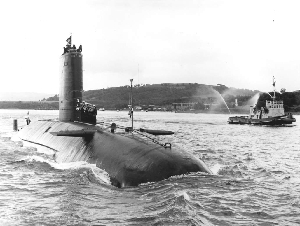
HMS Conqueror was a British Churchill-class nuclear-powered fleet submarine which served in the Royal Navy from 1971 to 1990. She was the third submarine of her class, following the earlier Churchill and Courageous, that were all designed to face the Soviet threat at sea. She was built by Cammell Laird at Birkenhead.
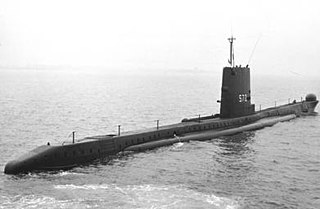
HMS Aeneas (P427) was a British Amphion-class submarine of the Royal Navy, built by Cammell Laird and launched on 9 October 1945. It was named after the hero Aeneas from Greek mythology.

HMS Onyx was an Oberon class submarine of the Royal Navy.
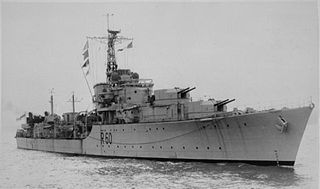
HMS Sluys was a Battle-class destroyer of the Royal Navy (RN). She was named in honour of the Battle of Sluys which occurred in 1340 during the Hundred Years' War, and which resulted in a decisive English victory over a French fleet. Sluys was built by Cammell Laird of Birkenhead. She was launched on 28 February 1945 and commissioned on 30 September 1946. In 1967, the ship was transferred to Pahlavi Iran and renamed Artemiz. In 1985, the ship was renamed again, this time Damavand.

The Le Redoutable-class submarine was a ballistic missile submarine class of the French Navy. In French, the type is called Sous-marin Nucléaire Lanceur d'Engins (SNLE), literally "Missile-launching nuclear submarine". When commissioned, they constituted the strategic part of the naval component of the French nuclear triad, then called Force de frappe.

The latest HMS Warspite was the third of Britain's nuclear-powered submarines, and the second of the Valiant class. After entering service in 1967 she collided with a Soviet submarine the following year. A mechanical failure associated with the submarine's nuclear reactor in 1991 led to the boat being laid up at HMNB Devonport where she awaits disposal.

HMS Yarmouth was the first modified Type 12 frigate of the Rothesay class to enter service with the Royal Navy.

HMS Sealion (S07) was a Porpoise-class submarine.

HMS Repulse (S23) was a Resolution-class ballistic missile submarine of the Royal Navy.

HMS Revenge (S27) was the fourth of the Royal Navy's Resolution-class ballistic missile submarines.

HMS Londonderry was a Rothesay- or Type 12-class anti-submarine frigate of the British Royal Navy in service from 1960 to 1984.

HMS Brighton was a Rothesay or Type 12I class anti-submarine frigate of the Royal Navy.

HMS Lowestoft was a Rothesay-class or Type 12 class anti-submarine frigate of the British Royal Navy. Lowestoft was reconstructed in the late 1960s to largely the same pattern as the third group of Leander-class frigates, with new radar and fire control and a hangar and pad for a Westland Wasp helicopter for longer range, anti-submarine, engagement. In the late 1970s it was converted as the prototype towed array frigate for the Royal Navy, but retained its full armament. Lowestoft was sunk as a target on 8 June 1986 by HMS Conqueror using a Tigerfish torpedo. She was the last Royal Naval target to be sunk still displaying her pennant number.
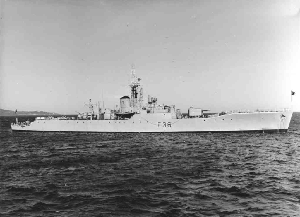
HMS Whitby was a Whitby-class or Type 12 anti-submarine frigate of the Royal Navy of the United Kingdom built by Cammell Laird and Co Ltd, Birkenhead. She was launched on 2 July 1954 and commissioned on 10 July 1956.

HMS Narwhal (S03) was a Porpoise-class submarine of the Royal Navy. She was launched on 25 October 1957.
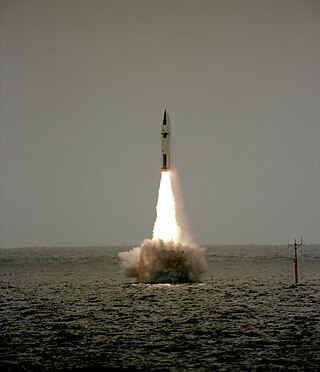
The United Kingdom's Polaris programme, officially named the British Naval Ballistic Missile System, provided its first submarine-based nuclear weapons system. Polaris was in service from 1968 to 1996.





















